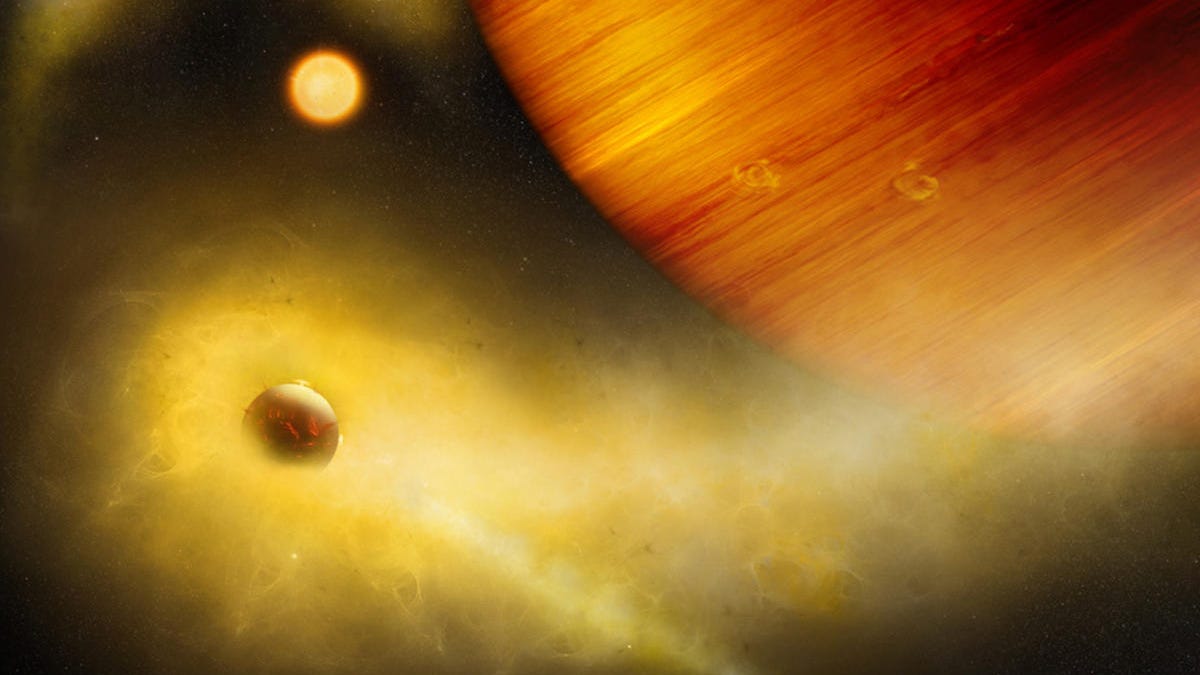Astronomers find hints of a dangerous lava world hidden by giant planet
Scientists have the high ground, suggesting a distant planet hides a hellish exomoon resembling Star Wars' Mustafar.

An illustration of a volcanic exo-Io with patches of sodium clouds trailing the lunar orbit, possibly driven by the gas giant's magnetosphere
Scientists say there could be a rocky exomoon 550 light-years away with a hellish lava-strewn surface like the fictional world of Mustafar where Anakin Skywalker faced off against Obi-Wan Kenobi in a fateful duel.
An exomoon is a natural satellite that exists around a planet outside our solar system. Astronomers are pretty sure they exist, but they're yet to make a definitive detection (and some even think exomoons may have moons which support alien life which they call "moon-moons").
In a study, set to be published in The Astrophysical Journal and available as a pre-print on arXiv, researchers from the University of Bern detail this new exomoon candidate. Sodium gas detected near the giant planet WASP-49b suggests a volcanic exomoon, similar to Jupiter's fiery moon Io, could exist in its orbit.
"The neutral sodium gas is so far away from the planet that it is unlikely to be emitted solely by a planetary wind," says Apurva Oza, postdoctoral fellow at Switzerland's University of Bern, in a release. The exomoon "would be a dangerous volcanic world with a molten surface of lava ... a place where Jedi go to die, perilously familiar to Anakin Skywalker."
For the record, Anakin Skywalker didn't die on the molten surface of Mustafar, but it is where Kenobi confirmed that the fallen Jedi's conversion to a dark-hearted Sith Lord was complete.
To be clear, the researchers have not directly observed a moon around the gas giant WASP-49b. Instead they found hints that such a volcanic exomoon could be there in the form of the sodium gas and the right conditions for such a surly satellite to survive.
Oza's work shows that a highly volcanic exomoon might be spewing sodium and potassium into space. Jupiter's moon Io was the best solar system equivalent for such a phenomenon which led the research team to suggest the signal they are seeing around WASP-49b relates to an "exo-Io."
However, Oza concedes that a large ring of ionized gas surrounding WASP-49b could also explain the presence of the detected sodium gas.
"We need to find more clues," he says.
If the volcanic exomoon is there, it might be even more strange than Mustafar, because it'd be orbiting a huge, hot gas giant planet that laps its host star in less than three days. Conditions like that would surely be too intense for even a Jedi master, but perhaps the upcoming Star Wars: The Rise of Skywalker will surprise us with more lava-meets-lightsaber battle scenes.
Originally published 1:59 p.m. PT
Updated 3:40 p.m. PT: Additional exomoon information and study information.



